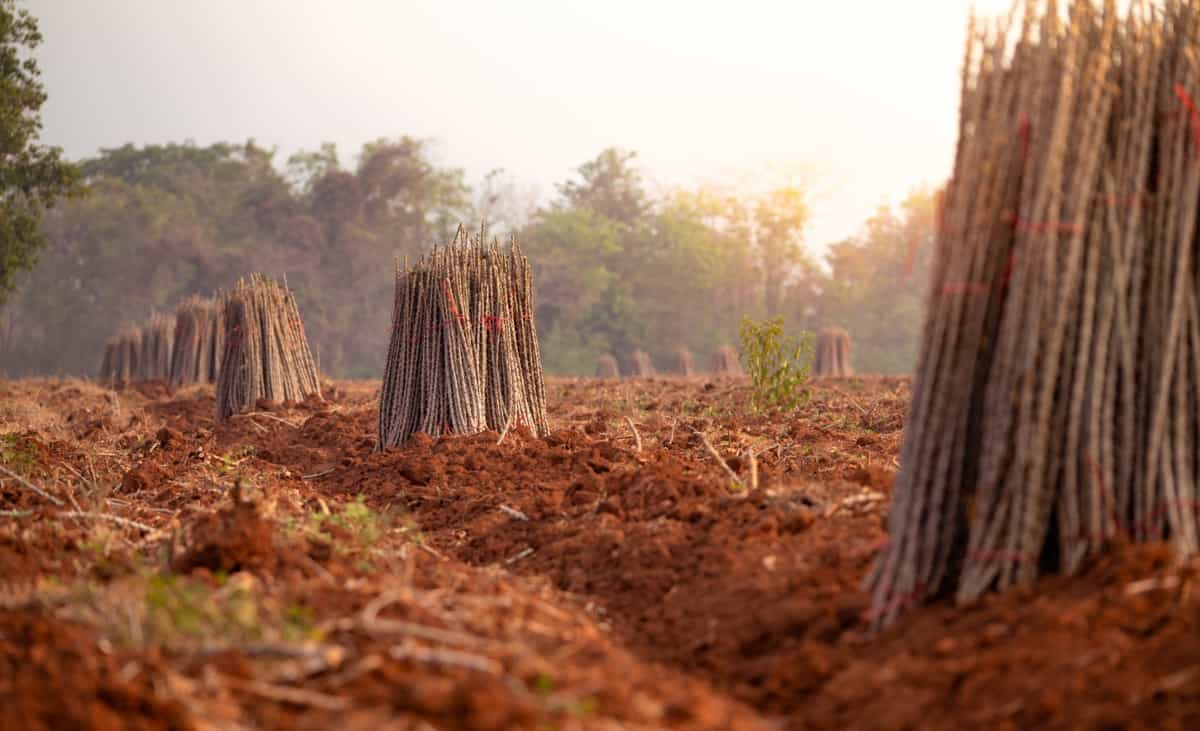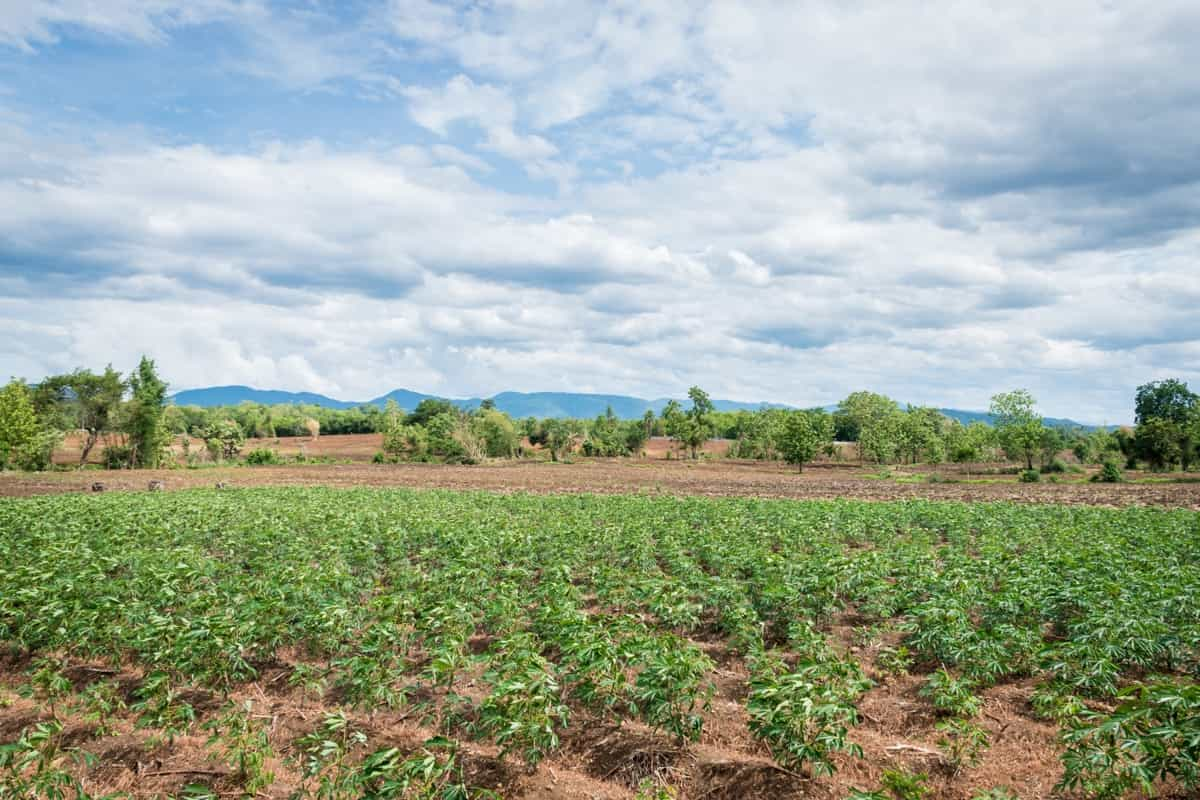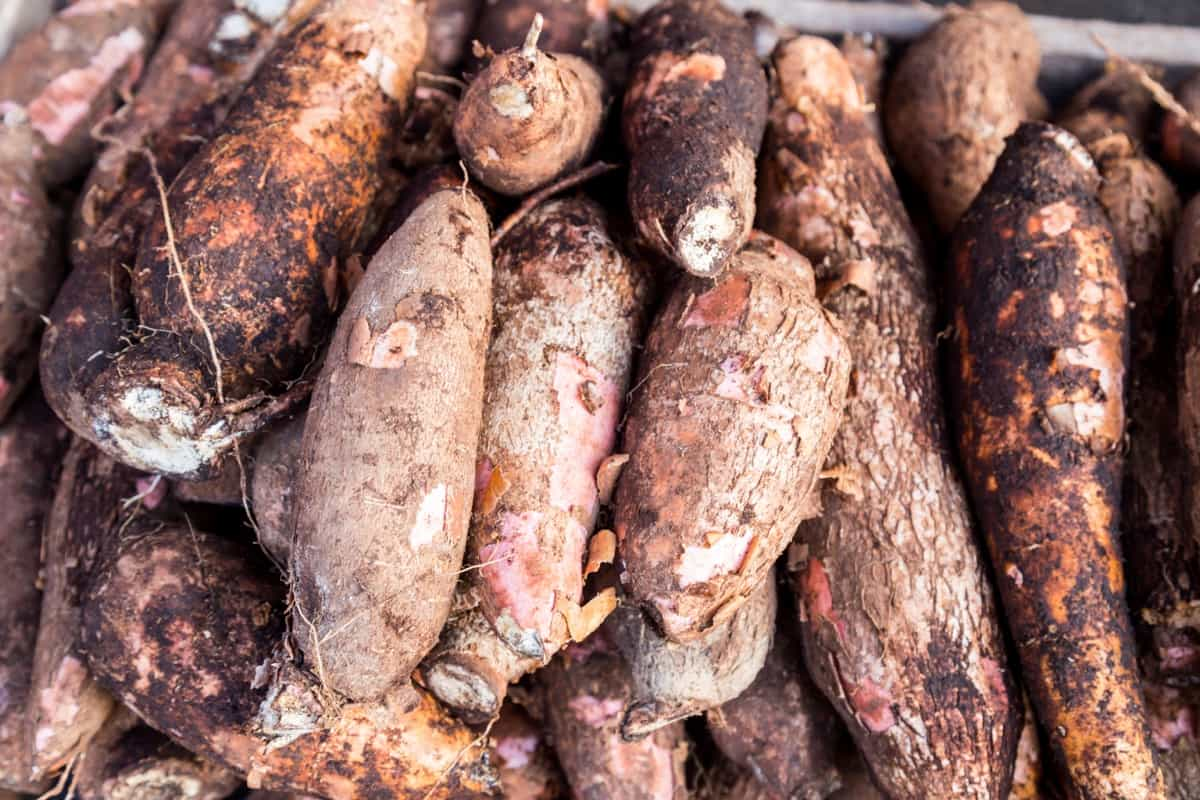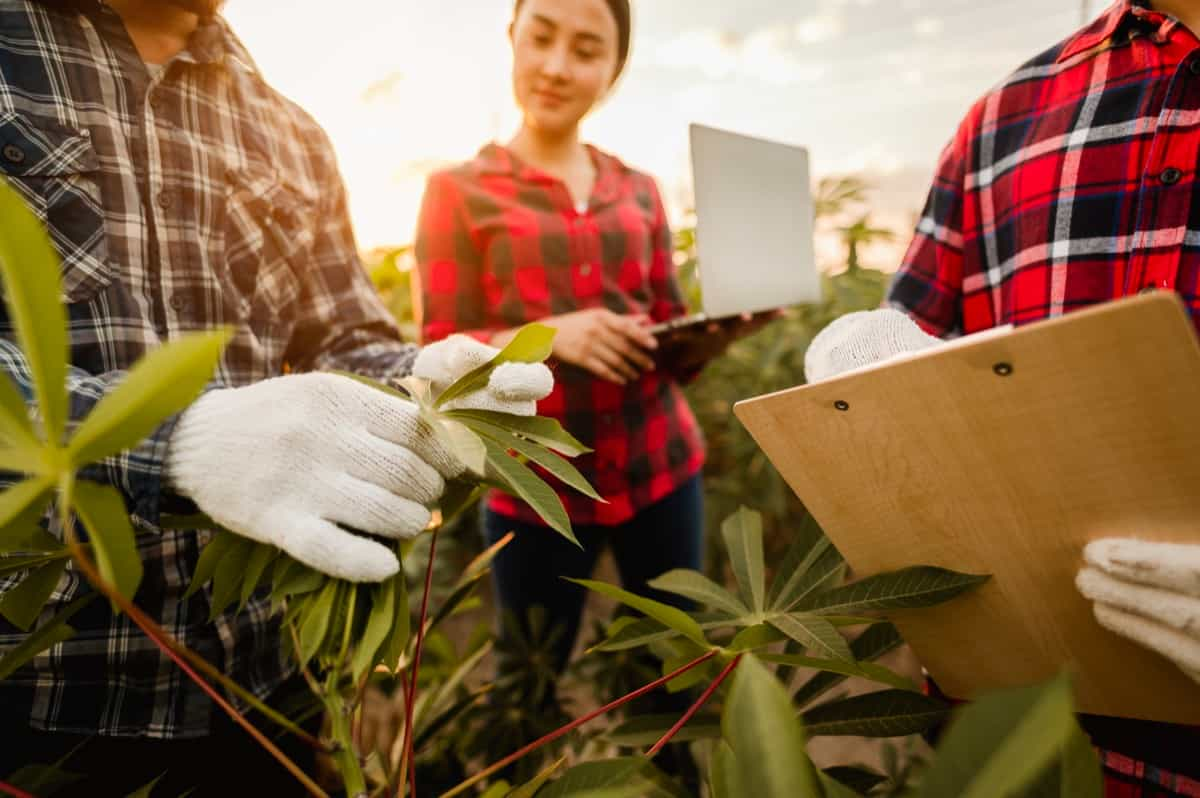Cassava farming is a Profitable business venture that offers great profit potential, especially in tropical regions where it is widely grown. However, to ensure success and profitability, it is crucial to have a comprehensive business plan that covers all aspects of cassava farming, from seed to marketing and processing.

According to Food and Agriculture Organization, it is the third most important source of food with calories for human consumption in the tropics, with an estimated global production of over 280 million tons annually. With the right planning, cassava farming can provide farmers with a sustainable source of profits and promote food security in local communities.
Cassava Farming Business Plan
What is Cassava Farming?
Cassava farming is the practice of cultivating the cassava plant, which is a tropical crop that is widely grown in Africa, Asia, and Latin America. Cassava (Manihot esculenta) is a Euphorbiaceae plant. Perennial woody shrub with a strong and woody stem. Carbohydrate-rich roots are edible. The bush grows to 9 feet tall and has 30-centimeter tubers. Some reach a meter. Tapioca is processed cassava roots. Patients in India eat tapioca pearls.
Cassava is an important source of calories for millions of people in developing countries. It produces various food products, including flour, starch, and alcohol. It is a hardy and heat-tolerant crop that can overcome drought and other harsh environmental conditions, making it an ideal crop for farmers in tropical regions. Cassava farming can have both positive and negative environmental impacts. Poorly managed cassava farming can lead to soil degradation, deforestation, and biodiversity loss.
In case you missed it: Rice Cultivation in Greenhouse: A Profitable Business Plan for Sustainable Farming

Why Start a Cassava Farming Business?
- High demand: Cassava is a staple crop in many regions of the world, and demand for items made from it, including flour and starch, is rising.
- Low production costs: Because cassava is a hardy and tolerant crop that needs minimal upkeep and can tolerate drought and other extreme environmental conditions, it is comparatively cheap to grow.
- Profitability: Depending on the demand of the market, cassava farming can be a successful business. Potential profits can range from 30 to 60%.
- Employment: Cassava cultivation can provide local populations with employment possibilities, reducing poverty and enhancing the standard of living.
- Sustainable agriculture: When properly managed cassava cultivation is properly managed, it can support sustainable agricultural practices and help protect the environment.
Benefits of Cassava Farming Business
- Food security: Cassava is an important source of calories for millions of people in developing countries, and it is a key crop for ensuring food security.
- Income generation: Cassava farming can provide a sustainable source of income for farmers, especially in rural areas where alternative income opportunities may be limited.
- Drought tolerance: Cassava is a hardy-tolerant crop that can withstand drought and other adverse climatic conditions, making it profitable for farmers in tropical regions.
- Versatility: Cassava can be processed into a wide range of food products, including flour, starch, and alcohol, providing multiple income streams for farmers.
- Environmental benefits: Properly managed cassava farming can help to restore degraded lands, prevent soil erosion, and promote biodiversity.
- Employment opportunities: Cassava processing can create employment opportunities in rural regions, particularly for women and youth.
- Economic development: Cassava processing can contribute to local economic development by creating value-added products and generating export revenues.
Cassava Farming Business Plan
A cassava farming business plan should include a detailed analysis of the production process, cost of production, marketing and sales strategies, financial projections, and a risk management plan. Identify the target market and develop a value-added product plan to increase revenue.
In case you missed it: Buzzing Towards Success: Creating a Comprehensive Beekeeping Business Plan

Access to affordable and reliable farming inputs, such as fertilizers and improved seed varieties, should also be considered. The plan should also include strategies to mitigate post-harvest losses through proper storage, processing, and value addition. Adequate funding and financial management are critical for business growth and sustainability.
Conducting a Market Analysis for the Cassava Farming Business
- Market size: It is crucial to calculate the potential size of the local and international markets for cassava and its related products. The yearly global cassava production is about 280 million tons, as reported by the Food and Agriculture Organization (FAO).
- Demand and supply: The unique features of the cassava market’s demand and supply are necessary for understanding the market and building an effective approach. Cassava agricultural inputs, such as land, water, and fertilizer, must be evaluated, as must the present and projected demand for cassava and its products.
- Competition: Threats and opportunities can be gleaned from examining the firm’s rivals in the cassava market. The current production and pricing tactics and the market share of cassava farmers and processors must be evaluated.
- Market trends: Keeping up-to-date with market trends in cassava farming and processing can help to identify new opportunities and potential challenges for the business.
- Value addition: Assessing the potential value-added products produced from cassava can help increase business revenue and profitability.
Developing a Production Plan for the Cassava Farming
- Select the right variety: Choose a suitable variety for your soil type and climate. Many cassava varieties have varying growth rates and disease resistance, so select the one that best suits your needs. Choosing the right variety is crucial to yielding according to your needs. There are many varieties available, which vary from country to country.
- Prepare the soil: Clear the land of weeds and debris and ensure the soil is well-drained. The red laterite soil is most suitable for farming. Sandy loam soil is also beneficial. Use organic fertilizers to enrich the soil and improve the yield. Tapioca grows in soil pH ranges of 4.5 to 8.0. Cassava prefers temperatures between 25 and 29 °C (77 and 84 °F), but it can survive in temperatures ranging from 12 to 40 °C (54 to 104 °F).
In case you missed it: How to Craft a Successful Vertical Farming Business Plan

- Planting: Cassava is propagated by planting stem cuttings of around 15 cm in length before the wet season begins. Plant cassava stems in rows or mounds, ensuring they are not too deep in the soil. Cassava requires regular watering, especially during the first few weeks of planting. Planting seedlings from the nursery to the main field requires loose, moist soil. Loosen the dirt around the crop. Plant stem cuttings 5cm deep. Deeper planting may cause swelling and low yield.
- Drip irrigation is the most used sort of irrigation method for watering plants. Flooding the field is not recommended since tapioca cannot withstand large amounts of water. Drip also guarantees that water is only distributed at the plant’s base, near its roots.
- Weed management: Weeds can compete with cassava for nutrients, water, and sunlight. Regularly weeding the farm to keep the soil healthy and promote growth is important.
- Pest and disease control: Tapioca plants are susceptible to common diseases such as anthracnose, cassava mosaic disease, and bud necrosis. Insect pests such as nematodes, grasshoppers, cassava scales, and witches’ broom can also harm tapioca crops. Disease-free stakes, resistant varieties, and proper pest management can help control these issues. Mealybugs and other pests and diseases, such as cassava mosaic disease, can harm cassava. Regular inspection and treatment can help prevent damage and yield loss.
- Harvesting: Harvest mature cassava roots between 8-12 months after planting. Use a machete or hoe to cut the stem of the cassava plant and remove the tubers from the ground. The average yield of cassava is 10-15 tonnes per acre.
- Processing: After harvesting, process the cassava roots into various products such as garri, fufu, tapioca, starch, and flour. Use appropriate processing methods to ensure quality and safety.
- These production plans allow you to grow cassava successfully, maximize yield, continuously improve your farming techniques, and stay updated on modern farming technologies to increase productivity and profitability.
In case you missed it: How to Start Profitable Pygmy Goat Farming: Business Plan and Requirements

Cassava Farming Financial Plan
- Cost of production: The cost of producing one hectare of cassava can vary depending on factors such as land preparation, planting, fertilization, pest control, and harvesting. The average cost ranges from $1,200 to $1,500 per hectare.
- Expected yield: The average cassava yield per hectare is around 20 to 30 tons, depending on the farming practices and variety.
- Market price: The market price of cassava varies based on location and demand. The price ranges from $0.25 to $0.50 per pound in the United States.
- Revenues: Based on the yield and market price, a one-hectare farm could generate revenues of $10,000 to $15,000.
- Profit: After deducting the cost of production from the revenues, the profit per hectare could range from $8,500 to $13,500.
- Return on investment (ROI): The ROI for a cassava farming business can vary depending on the initial investment and other factors. However, with an average profit of $5,000–10,000 per hectare, a 100-hectare farm could generate $1 million annually.
Marketing and Sales Plan for Cassava Business
- Determine the specific market segment to focus on, such as food processing industries, animal feed manufacturers, or households.
- Create a distinct brand that distinguishes your cassava goods from competitors.
- Establish a distribution network: Create channels to ensure products are available to customers.
- Use technology to improve brand visibility and reach new customers, such as social media, e-commerce platforms, and digital marketing tools.
- Set moderate prices that entice customers while also maintaining a profit.
- Develop relationships: cultivate positive ties with suppliers, customers, and industry stakeholders.
- Participate in exhibits and trade shows to market your business and network with potential consumers.
Post-harvesting management operations in the Cassava Farming business
After harvesting, cassava is susceptible to post-harvest physiological deterioration (PPD) due to the accumulation of reactive oxygen species (ROS). This results in a blackened and unpalatable tuber, limiting its shelf life and export potential. However, overexpressing a cyanide-insensitive alternative oxidase can increase shelf life by up to three weeks by suppressing ROS. Breeding cassava varieties more tolerant to PPD has also been explored.
In 2020, Nigeria was the world’s largest cassava producer, with 60 million tonnes produced. Cassava is a drought-tolerant crop that can grow well in marginal soils and poor pH levels, making it suitable for certain parts of Africa and South America. Cassava can be processed into various products, such as cassava starch, flour, and bread, and can be preserved using fungicides, plastic wrapping, wax coating, or freezing.
Processing and Value Addition in Cassava Farming
- Cassava can be processed into value-added products such as flour, starch, chips, and ethanol.
- Cassava flour is used as a substitute for wheat flour in many gluten-free products, while cassava starch is used to produce food and non-food products.
- Cassava chips are used for animal feed and industrial purposes such as ethanol production.
- Ethanol can be produced from cassava by fermentation and distillation and can be used as a biofuel or source of industrial alcohol.
- Processing cassava involves peeling, washing, grating, and pressing the roots to extract the starch, which is dried and packaged.
- Value-addition activities in cassava farming can increase the crop’s profitability and improve farmers’ livelihoods.
- Cassava value chains are important for creating market linkages and improving the competitiveness of cassava-based products.
- Several countries have established cassava processing zones to promote value addition and create employment opportunities.
In case you missed it: Key Rules to Start Totapari Goat Farming from Scratch: Requirements and Business Plan

Risk Management Plan in the Cassava Farming Business
Some common risks in cassava farming include weather fluctuations, pests and diseases, market volatility, and price fluctuations. Farmers should consider implementing risk management strategies such as crop diversification, pest and disease control measures, market analysis and price forecasting, and crop insurance to mitigate these risks.
Additionally, farmers can invest in research and development to improve crop yields and disease resistance. It is also essential to maintain good relationships with suppliers, buyers, and other stakeholders in the cassava value chain to ensure a stable market for the produce.
Conclusion
A comprehensive cassava farming business plan is essential for success in the cassava industry. With a clear understanding of market demand, production costs, marketing strategies, and risk management, farmers can maximize their profits and ensure the long-term viability of their businesses. By focusing on these key components, farmers can grow their profits and succeed in the competitive world of cassava farming.
- Economical Aquaculture: A Guide to Low-Budget Fish Farming
- 15 Common Planting Errors That Can Doom Your Fruit Trees
- How to Make Houseplants Bushy: Effective Tips and Ideas
- Innovative Strategies for Boosting Coconut Pollination and Yield
- Pollination Strategies for Maximum Pumpkin Yield
- The Complete Guide to Chicken Fattening: Strategies for Maximum Growth
- Natural Solutions for Tulip Problems: 100% Effective Remedies for Leaf and Bulb-Related Issues
- Revolutionizing Citrus Preservation: Towards a Healthier, Greener Future
- Natural Solutions for Peony Leaf and Flower Problems: 100% Effective Remedies
- Maximizing Profits with Avocado Contract Farming in India: A Comprehensive Guide
- Natural Solutions for Hydrangea Problems: 100% Effective Remedies for Leaf and Flowers
- The Ultimate Guide to Choosing the Perfect Foliage Friend: Bringing Life Indoors
- From Sunlight to Sustainability: 15 Ways to Use Solar Technology in Agriculture
- The Ultimate Guide to Dong Tao Chicken: Exploring from History to Raising
- The Eco-Friendly Makeover: How to Convert Your Unused Swimming Pool into a Fish Pond
- Mastering the Art of Delaware Chicken Farming: Essentials for Healthy Backyard Flocks
- 20 Best Homemade Fertilizers for Money Plant: DIY Recipes and Application Methods
- How to Craft a Comprehensive Free-Range Chicken Farming Business Plan
- Brighten Your Flock: Raising Easter Egger Chickens for Beauty and Bounty
- How to Optimize Your Poultry Egg Farm Business Plan with These Strategies
- Subsidy for Spirulina Cultivation: How Indian Government Schemes Encouraging Spirulina Farmers
- Ultimate Guide to Raising Dominique Chickens: Breeding, Feeding, Egg-Production, and Care
- Mastering the Art of Raising Jersey Giant Chickens: Care, Feeding, and More
- Ultimate Guide to Raising Legbar Chickens: Breeding, Farming Practices, Diet, Egg-Production
- How to Raise Welsummer Chickens: A Comprehensive Guide for Beginners
- How to Protect Indoor Plants in Winter: A Comprehensive Guide
- Ultimate Guide to Grow Bag Gardening: Tips, Tricks, and Planting Ideas for Urban Gardeners
- Guide to Lotus Cultivation: How to Propagate, Plant, Grow, Care, Cost, and Profit
- Agriculture Drone Subsidy Scheme: Government Kisan Subsidy, License, and How to Apply Online
- Ultimate Guide to Raising Araucana Chickens: Breed Profile, Farming Economics, Diet, and Care
- Bringing Hydroponics to Classroom: Importance, Benefits of Learning for School Students
- Ultimate Guide to Raising Polish Chickens: Breed Profile, Farming Economics, Diet, and Care
- Ultimate Guide to Raising Australorp Chickens: Profile, Farming Economics, Egg Production, Diet, and Care
- Silkie Chicken Farming: Raising Practices, Varieties, Egg Production, Diet, and Care
- Sussex Chicken Farming: Raising Practices, Varieties, Egg Production, Diet and Care
- Homemade Feed Formulations for Livestock: Discover Cost-effective Starter to Finisher Feed Recipes
This is a good guide to extension workers.
Very detailed and insightful. How can I engage your services?